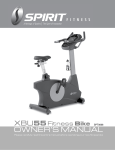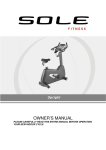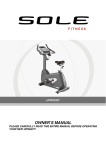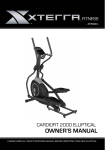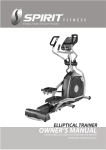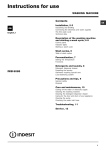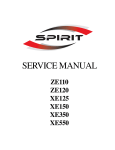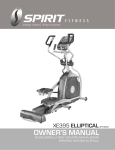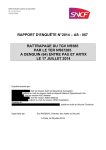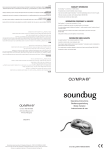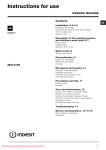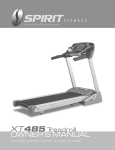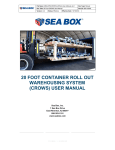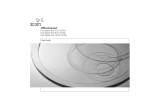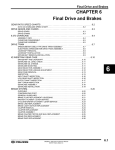Download XBU55_Owner`s Manual
Transcript
Fitness Bike OWNER’S MANUAL Please carefully read this entire manual before operating your new fitness bike Table Of Contents Important Safety Instructions……………………………………………………...5 Important Electrical Instructions……………………………………………….….6 Assembly Instructions…………………………………………............................7 Product Features………………………………………………………………….13 Operation of Your Console………………………………………………........…15 Programmable Features……………………………………………..…...….…..20 Using A Heart Rate Transmitter……………………………………………..…...26 General Maintenance…………………………………………………….…….....28 Exploded View Diagram…………………………………………………...…......29 Parts List…………………………………………………………………….......….30 ATTENTION This fitness bike is intended for residential use only and is warranted for this application. Any other application voids this warranty in its entirety. XU315-SB002_1406(SL)A_ 2 Important Safety Instructions WARNING - Read all instructions before using this appliance. If using the optional power supply: DANGER - To reduce the risk of electric shock disconnect your fitness bike from the electrical outlet prior to cleaning and/or service work. WARNING - To reduce the risk of burns, fire, electric shock, or injury to persons, install the fitness bike on a flat level surface with access to a 220-volt, 10-amp grounded outlet with only the fitness bike plugged into the circuit. DO NOT USE AN EXTENSION CORD UNLESS IT IS A 14AWG OR BETTER, WITH ONLY ONE OUTLET ON THE END: Do not operate fitness bike on deeply padded, plush or shag carpet. Damage to both carpet and fitness bike may result. Keep children away from the fitness bike. There are obvious pinch points and other caution areas that can cause harm. Keep hands away from all moving parts. Never operate the fitness bike if it has a damaged cord or plug. If the fitness bike is not working properly, call your dealer. Keep the cord away from heated surfaces. Do not operate where aerosol spray products are being used or where oxygen is being administered. Sparks from the motor may ignite a highly gaseous environment. Never drop or insert any object into any openings. Do not use outdoors. To disconnect, turn all controls to the off position, then remove the plug from the outlet. Do not attempt to use your fitness bike for any purpose other than for the purpose it is intended. The hand pulse sensors are not medical devices. Their purpose is to provide you with an approximate measurement in relation to your target heart rate. Use of a chest transmitter strap (sold separately) is a much more accurate method of heart rate analysis .Various factors, including the user’s movement, may affect the accuracy of heart rate readings. The pulse sensors are intended only as exercise aids in determining heart rate trends in general. Wear proper shoes. High heels, dress shoes, sandals or bare feet are not suitable for use on your fitness bike. Quality athletic shoes are recommended to avoid leg fatigue. This appliance is not intended for use by persons (including children) with reduced physical, sensory or mental capabilities, or lack of experience and knowledge, unless they have been given supervision or instruction concerning use of the appliance by a person responsible for their safety. Children should be supervised to ensure that they do not play with the appliance. SAVE THESE INSTRUCTIONS - THINK SAFETY! CAUTION!! Please be careful when opening this unit. 3 Important Electrical Instructions WARNING! NEVER remove any cover without first disconnecting AC power. If voltage varies by ten percent (10%) or more, the performance of your fitness bike may be affected. Such conditions are not covered under your warranty. If you suspect the voltage is low, contact your local power company or a licensed electrician for proper testing. NEVER expose this fitness bike to rain or moisture. This product is NOT designed for use outdoors, near a pool or spa, or in any other high humidity environment. The operating temperature specification is 40 to 120 degrees Fahrenheit, and humidity is 95% non-condensing (no water drops forming on surfaces). Important Operation Instructions NEVER operate this fitness bike without reading and completely understanding the results of any operational change you request from the computer. Understand that changes in resistance do not occur immediately. Set your desired resistance level on the computer console and release the adjustment key. The computer will obey the command gradually. NEVER use your fitness bike during an electrical storm. Surges may occur in your house- hold power supply that could damage fitness bike components. Unplug the fitness bike during an electrical storm as a precaution. Use caution while participating in other activities while pedaling on your fitness bike; such as watching television, reading, etc. These distractions may cause you to lose balance which may result in serious injury. Do not use excessive pressure on console control keys. They are precision set to function properly with little finger pressure. 4 Assembly Instructions Pre-Assembly 1. 2. 3. Using a razor knife (Box Cutter), cut the banding straps that wrap around the carton. Reach under the bottom edge of the carton and pull it away from the cardboard underneath, separating the staples that join the two together. Lift the box over the unit and unpack. Carefully remove all parts from carton and inspect for any damage or missing parts. If damaged parts are found, or parts are missing, contact your dealer immediately. Locate the hardware package. The hardware is separated into four steps. Remove the tools first. Remove the hardware for each step as needed to avoid confusion. The numbers in the instructions that are in parenthesis (#) are the item number from the assembly drawing for reference. Assembly Tools #93. Phillips Head Screwdriver #100. 12/14mm Wrench 5 #92. 13/15mm Wrench STEP 1: Rear Stabilizer 1. Install the Rear Stabilizer (5) onto the Main Frame (1) with the four Hex Head Bolts (50) and four Flat Washers (71).Tighten using the Wrench (100). HARDWARE #71. 3/8” × 25 × 2T Flat Washer (4 pcs) #50. 3/8” × 2-1/4” Hex Head Bolt (4 pcs) 6 STEP 2: Console Mast 1. 2. Unravel the Computer Cable (29) and snake it through the Console Mast Cover (38) and the Console Mast (2) until the cable connector comes out the top opening of the console mast. Slide the plastic cover (38) onto the console mast, ensuring the correct orientation of the cover. Install the Console Mast (2) onto the Main Frame (1) with seven Hex Head Bolts (51), six Flat Washers (72) on the side bolts and one Curved Washer (99) on the front bolt. Tighten using the Wrench (100). HARDWARE #51. 5/16” × 5/8” Hex Head Bolt (7 pcs) #72. 5/16” × 18 × 1.5T Flat Washer (6 pcs) 7 #99. 5/16” × 19 × 1.5T Curved Washer (1 pc) STEP 3: Handle Bars 1. 2. Run the two hand pulse wires (26) into the hole in the handle bar mounting plate and out through the hole in the console plate. Remove the black plastic cover from the handlebars by cutting the plastic tie. Install the Handle Bar (3) onto the Console Mast (2) with two Hex Head Bolts (51), two Flat Washers (72), and two Split Washers (103), being careful not to pinch the hand pulse wires. Tighten using the Wrench (100). Snap the black plastic handlebar cover over the joint. HARDWARE #51. 5/16” × 5/8” Hex Head Bolt (2 pcs) #72. 5/16” × 18 × 1.5T Flat Washer (2 pcs) 8 #103. 5/16” × 1.5T Split Washer (2 pcs) 9 STEP 4: Console, Seat, Covers & Pedals 1. 2. 3. 4. 5. Insert the Computer Cable (29) and two Hand pulse cables (26, 28) into the connectors in the back of the Console (34). Install the Console (34) onto the Console Mast (2). Install the four Phillips Head Screws (58) with the Phillips Head Screw Driver (93). Install the Front Stabilizer Cover (40) and the Rear Stabilizer Cover (41) onto the Main Frame (1) with four Phillips Head Screws (58).Tighten using the Phillips Head Screw Driver (93). Install the Pedals (45L, 46R) onto the Crank arms (16L, 16R). Remember that the left pedal has a reverse thread and will be screwed into the crank in the opposite rotation from normal threads. There is an ”L” stamped into the end of the threaded post of the left pedal and an ”R” in the right. Make sure to tighten the pedals as much as you possibly can. It may be necessary to re-tighten the pedals if you feel a thumping while pedaling the bike. A noise or feeling such as a thumping or clicking is usually caused by the pedals being too loose. Tighten using the Wrench (92). Install the Seat mount slide (7) (post at the front) onto the track on top of the seat bracket (6) by sliding a Flat Washer (71) onto the seat adjustment knob (86), then slide it through the slots of each and attach a flange nut (8) to the end. Install the seat (19) onto the seat post by securely tightening the nut on each the side, below the seat. Install the Drink Bottle Holder (116) onto the Console Mast (2) with two Phillips Head Screws (58).Tighten using the Phillips Head Screw Driver (93). HARDWARE #58. M5 × 12mm Phillips Head Screw (10 pcs) 10 Product Features Pedals Through research performed with a leading sports scientist and physical rehabilitation expert, our engineering has developed a breakthrough in pedal design. Typical stationary exercise bikes are wider than a normal road bike. The reason is to allow for the braking mechanism, pulleys, drive components and plastic covers. Since the bike is wider, so is the distance between the pedals; this width between the pedals is called the Q factor. We have designed our pedal system so the Q factor is the smallest in the industry, but we did not stop there. We have also custom designed and tooled a new pedal that provides a 2° inward tilt to compensate for the Q factor not being perfect. Having a small Q factor in addition to the 2° inward tilt of the pedals puts the user into a biomechanical neutral alignment. This means that your feet, ankles, knees and hips are lined up properly ensuring a comfortable workout. Transportation The fitness bike is equipped with two transport wheels that are engaged when the rear of the fitness bike is lifted. Seat Adjustability When adjusting the seat to a higher position, just pull up on the seat. The design features a ratcheting mechanism that will lock into place. If you need to lower the seat, pull horizontally on the on the right side of the frame until the post locks into one of the grooves. Console The console will display RPM, Calories burned, Time (elapsed or countdown), Distance travelled, Pulse, Resistance Level, Program Name, Speed, Watts, and number of Laps completed. There is also a resistance level profile graph that lets you see how hard you have worked and how challenging the upcoming segments will be. 11 MUSCLE ACTIVATION FIGURE There is an anatomical figure located at the top of the console. This figure will light all areas that are activated when using the bike. These will light up during any of the programs. You can control which muscles are activated by customizing the resistance profile during the set up phase of console programming. If you accept the default program profile, the selected program will determine which muscles will be activated by automatically adjusting the resistance. Generally the following guidelines hold true: • The upper body LED’s will not light • The lower body lights will activate in three degrees of engagement: Green represents minimal muscle involvement, yellow represents medium involvement, and red represents full or heavy activation. • These are the different scenarios for lower body muscle activation: • Levels 1-10: Green – Hamstrings & Gluteals light up; Yellow –Quadriceps & Calves light up • Levels 11-20: Yellow – Hamstrings & Gluteals light up; Red–Quadriceps & Calves light up HEART RATE % PROFILE The console LCD screen will display your current heart rate anytime a pulse is detected. The Bar Graph, located to the right of the LCD screen, will show your current heart rate % in relation to your projected maximum heart rate, which is determined by your age that you entered during the programming phase of any of the 10 programs. The significance of the bar graph colors are as follows: • 50-60% of maximum is Amber • 65-80% of maximum is Amber and Green • 85-90% or more is Amber, Green, and Red 12 Operation of Your Console Console Integrated Speak ers for MP3 Play er Musc le Ac tivation Profile Large LCD with sc rolling feedbac k and sc rolling mess age c enter Heart Rate % Profile Swiv el Fan to k eep y ou cool Ten innovativ e programs offer a variety of work -outs Eas y-Touc h Control Buttons Convenient c argo c ompartment for keys , phone, or MP3 play er Power When the A.C. Power cord is connected to the fitness bike, the console will automatically power up. If there is no input to the console for 20 minutes the console will go to stand-by mode. In stand-by mode the console display will turn off. To turn the console on press any key. When initially powered on the console will perform an internal self-test. During this time all the lights will turn on. When the lights go off, the Message Center will show the software version (i.e.: VER 1.0). The distance window shows the distance in miles and the time window shows the total hours of use. The dot matrix display will be scrolling through the different profiles of the programs and the message window will be scrolling the start up message. You may now begin to use the console. 13 Dot Matrix Center Display Twenty columns of boxes (8 high) indicate each segment of a workout. The boxes only show an approximate level (resistance) of effort. They do not necessarily indicate a specific value - only an approximate percent to compare levels of intensity. In Manual Operation the resistance dot matrix window will build a profile “picture” as values are changed during a workout. The resistance profiles will display half of the program at one time (9 columns).They will both scroll right to left. The Lap track will move in a counterclockwise direction. 1/4 Mile(0.4K) Track The 1/4-mile track (one lap) will be displayed around the dot matrix window. The flashing segment indicates your progress. Once the 1/4-mile (Metric - 0.4k) is complete this feature will begin again. There is a lap counter in the message window for monitoring your distance. Pulse Grip Feature The Pulse (Hear t Rate) console window will display your current hear t rate in beats per minute during the workout. You must use both stainless steel sensors on the front cross bar or the hear t rate transmitter chest strap to display your pulse. Pulse value displays anytime the upper display is receiving a Pulse signal. You may not use the Grip Pulse feature while in Hear t Rate Programs. Note: Refer to Important Safety Instructions (page 2) concerning Pulse Grip operation. Calorie Display Displays the cumulative calories burned at any given time during your workout. Note: This is only a rough guide used for comparison of different exercise sessions, which cannot be used for medical purposes. Speakers The console has built-in Speakers. You may plug an Audio Source (CD player, MP3, Computer, etc.) into the Jack on the right side of console. There is no volume control on the console. The volume must be controlled on the Audio Source. 14 Quick Start This is the quickest way to star t a workout. After the console powers up you just press the Start key to begin, this will initiate the Quick Star t mode. In Quick Star t the Time will count up from zero and the workload may be adjusted manually by pressing the LevelƒUp/ Down buttons.The dot matrix display will have only the bottom row lit at first. As you increase the work load more rows will light indicating a harder workout.The fitness bike will get harder to pedal as the rows increase. There are 20 levels of resistance available for plenty of variety.The first 5 levels are ver y easy workloads and the changes between levels are set to a good progression for de-conditioned users. Levels 6-10 are more challenging, but the increases in resistance from one level to the next remain small. Levels 11-15 star t getting tough as the levels jump more dramatically. Levels 16-20 are extremely hard and are good for shor t inter val peaks and elite athletic training. Basic Information The Message Center will initially be displaying the Program name. When in scan mode during a program, speed will be displayed for four seconds, then move on and display Watts (indication of workload). If 100 watts is displayed, you are doing enough work to keep a 100-watt light bulb lit.The data changes to Laps completed, Segment time, Max level. Pressing the Enter button again will bring you back to the beginning. The Stop button actually has several functions. Pressing the Stop key once during a program will pause the program for 5 minutes. If you need to get a drink, answer the phone or any of the many things that could interrupt your workout, this is a great feature.To resume your workout during Pause, just press the Start key. If the Stop button is pressed twice during a workout, the program will end and the console will display your Workout Summar y (Total time, Avg. Speed, Avg. Watts, Avg. HR, total Laps). If the Stop key is held down for 3 seconds or a third time during the program, the console will perform a complete Reset. During data entr y for a program the Stop key performs a previous screen or segment function.This allows you to go back to change programming data. 15 Program Keys The program keys are used to preview each program. When you first turn the console on you may press each program key to preview what the program profile looks like. If you decide that you want to try a program, press the corresponding program key and then press the Enter key to select the program and enter into the data-setting mode. The fitness bike has a built in hear t rate monitoring system. Simply grasping the hand pulse sensors on the stationary handle bars or wearing the hear t rate transmitter (see Using Hear t Rate Transmitter section) will star t the Hear t Icon blinking (this may take a few seconds).The Pulse Display Window will display your hear t rate, or Pulse in beats per minute. The console includes a built-in fan to help keep you cool. To turn the fan on, press the button on the left side of the console. Programming The Console Each of the programs can be customized with your personal information and changed to suit your needs. Some of the information asked for is necessary to ensure the readouts are correct. You will be asked for your Age and Weight. Entering your Age is necessary during the Hear t Rate programs to ensure the correct settings are in the program for your Age. Otherwise the work settings could be too high or low for you. Entering your Weight aides in calculating a more correct Calorie reading. Although we cannot provide an exact calorie count, we do want to be as close as possible. CALORIE NOTE: Calorie readings on ever y piece of exercise equipment, whether it is in a gym or at home, are not accurate and tend to vary widely. They are meant only as a guide to monitor your progress from workout to workout. The only way to measure your calorie burn accurately is in a clinical setting connected to a host of machines. This is because ever y person is different and burns calories at a different rate. Some good news is that you will continue to burn calories at an accelerated rate for at least an hour after you have finished exercising! Entering A Program And Changing Settings When you enter a program, by pressing a program key, then Enter key, you have the option of entering your own personal settings. If you want to workout without entering new settings, then just press the Start key. This will bypass the programming of data and take you directly to the star t of your workout. If you want to change the personal settings then just follow the instructions in the Message Center. If you star t a program without changing the settings, the default or saved settings will be used. NOTE: Age and Weight default settings will change when you enter a new number. So the last Age and Weight entered will be saved as the new default settings. If you enter your Age and Weight the first time you use the fitness bike, you will not have to enter it ever y time you work out unless either your Age or Weight changes, or someone else enters a different Age and Weight. 16 Manual The Manual program works as the name implies, manually. This means that you control the workload and not the computer. To star t the Manual program, follow the instructions below or just press the Manual button, then the Enter key and follow the directions in the Message Center. 1. Press the Manual key, then press the Enter key. 2. The Message Center will ask you to enter your Age. You may enter your age, using the Up/Down keys, then press the Enter key to accept the new value and proceed on to the next screen. . You are now asked to enter your Weight. You may adjust the Weight value using the Up/Down keys, then press Enter to continue. 4. Next is Time. You may adjust the Time and press Enter to continue. 5. Now you are finished editing the settings and can begin your workout by pressing the Start key. You can also go back and modify your settings by pressing the Stop key. NOTE: At any time during the editing of Data you can press the Stop key to go back one level, or screen. 6. Once the program starts you will be at level one. This is the easiest level and it is a good idea to stay at level one for a while to warm up. If you want to increase the work load at any time press the Up key; the Down key will decrease the work-load. 7. During the Manual program you will be able to scroll through the data in the Message Center by pressing the Enter key. 8. When the program ends you may press Start to begin the same program again or Stop to exit the program or you can save the program you just completed as a custom user program by pressing a User key and following the instructions in the Message Center. 17 Preset Programs The fitness bike has five different programs that have been designed for a variety of workouts. These five programs have factor y preset work level profiles for achieving different goals. HILL Resistance: This program follows a triangle or pyramid type of gradual progression from approximately 10% of maxi- mum effort (the level that you chose before star ting this program) up to a maximum effort which lasts for 10% of the total workout time, then a gradual regression of resistance back to approximately 10% of maximum effort. RESISTANCE FAT BURN Resistance: This program follows a quick progression up to the maximum resistance level (default or user input level) that is sustained for 2/3 of the workout. This program will challenge your ability to sustain your energy output for an extended period of time. RESISTANCE CARDIO Resistance: This program presents a quick progression up to near maximum resistance level (default or user input level). It has slight fluctuations up and down to allow your heart rate to elevate, and then recover repeatedly, before beginning a quick cool down. This will build up your heart muscle and increase blood flow and lung capacity RESISTANCE 18 STRENGTH Resistance: This program has a gradual progression of resistance up to 100% of maximum effort that is sustained for 25% of workout duration. This will help build strength and muscular endurance in the lower body and gluts. A brief cool down follows. RESISTANCE INTERVAL Resistance: This program takes you through high levels of intensity followed by recovery periods of low intensity. This program utilizes and develops your ”Fast Twitch” muscle fibers which are used when performing tasks that are intense and short in duration. These deplete your oxygen level and spike your heart rate, followed by periods of recovery and heart rate drop to replenish oxygen. Your cardiovascular system gets programmed to use oxygen more efficiently. RESISTANCE 19 Programming Preset Programs 1. Select the desired program button then press the Enter key. 2. The Message Center will ask you to enter your Age. You may adjust the age setting, using the Level Up/Down keys, then press the Enter key to accept the new number and proceed on to the next screen. 3. You are now asked to enter your Weight. You may adjust the Weight value using the Level Up/Down keys, then press Enter to continue. 4. Next is Time. You may adjust the time and press Enter to continue. 5. Now you are asked to adjust the Max Resistance Level. This is the peak exertion level you will experience during the program. Adjust the level and then press Enter. 6. Now you are finished editing the settings and can begin your workout by pressing the Start key. You can also go back and modify your settings by pressing the Enter key. 7. If you want to increase or decrease the resistance at any time during the program, press the Level Up/Down keys on the console or above the hear t rate sensor grips of the stationary handlebars. This will change the resistance settings of the entire profile, although the profile picture on the screen will not change. The reason for this is so that you can see the entire profile at all times. If the profile picture is changed, it also would be distorted and not a true representation of the actual profile. When you make a change to the resistance, the Message Center will show the current column and program maximum levels of work. 8. During the program you will be able to scroll through the data in the message window by pressing the Enter key. 9. When the program ends the Message Center will show a summary of your workout. The summary will be displayed for a short time, then the console will return to the star t-up display. 20 Custom User Defined Programs There are two customizable User programs that allow you to build and save your own workout. The two programs, Userƒ1 and Userƒ2, operate exactly the same way so there is no reason to describe them separately. You can build your own custom program by following the instructions below or you can save any other preset program you complete as a custom program. Both programs allow you to further personalize it by adding your name. 1. Press the User 1 or User 2 key. The Message Center will show a welcome message. If you had previously saved a program the message will contain your name. Then press the Enter key to begin programming. 2. When you press Enter, the Message Center will show “Name - A”, if there is no name saved. If the name “David” had been previously saved the Message Center will show “Name - David” and the D will be blinking. If there is a name saved you can change it or you may press the Stop key to keep the name and continue to the next step. If you want to enter a name use the Up/Down key to change the first letter then press Enter to save the first letter and continue to the next letter. When you have finished entering the name press the Stop key to save the name and continue to the next step. 3. The Message Center will ask you to enter your Age. You may enter your age, using the Level Up/Down keys, then press the Enter key to accept the new value and proceed on to the next screen. 4. You are now asked to enter your Weight. You may adjust the weight value using the Up/ Down keys or the numeric key pad, then press Enter to continue. 5. Next is Time. You may adjust the time and press Enter to continue. 6. Now you are asked to adjust the Max Resistance Level of the program, press Enter when resistance has been selected. 7. Now the first column will be blinking and you are asked to adjust the resistance level for the first segment(SEGMENT > 1) of the workout by using the Level Up key. When you finish adjusting the first segment, or if you don’t want to change, then press Enter to continue to the next segment. 8. The next segment will show the same workload resistance level as the previously adjusted segment. Repeat the same process as the last segment then press Enter. Continue this process until all twenty segments have been set. 9. The Message Center will then tell you to press Enter to save the program. After saving the program the Message Center says “New program saved” then will give you the option to star t or modify the program. Pressing Stop will exit to the star t up screen. 21 Heart Rate Programs “WARNING! Heart rate monitoring systems may be inaccurate. Over exercising may result in serious injury or death. If you feel faint stop exercising immediately“ Before we get started, a word about Heart Rate: The old motto, “no pain, no gain”, is a myth that has been overpowered by the benefits of exercising comfortably. A great deal of this success has been promoted by the use of heart rate monitors. With the proper use of a heart rate monitor, many people find that their usual choice of exercise intensity was either too high or too low and exercise is much more enjoyable by maintaining their heart rate in the desired benefit range. To determine the benefit range in which you wish to train, you must first determine your Maximum Heart Rate. This can be accomplished by using the following formula: 220 minus your age. This will give you the Maximum Heart Rate (MHR) for someone of your age. To determine the effective heart rate range for specific goals you simply calculate a percentage of your MHR. Your Heart rate training zone is 50% to 90% of your maximum heart rate. 60% of your MHR is the zone that burns fat while 80% is for strengthening the cardio vascular system. This 60% to 80% is the zone to stay in for maximum benefit. For someone who is 40 years old their target heart rate zone is calculated: 220 – 40 = 180 (maximum heart rate) 180 x .6 = 108 beats per minute (60% of maximum) 180 X .8 = 144 beats per minute (80% of maximum) So for a 40 year old the training zone would be 108 to 144 beats per minute. If you enter your age during programming the console will perform this calculation automatically. Entering your age is used for the Heart Rate programs. After calculating your MHR you can decide upon which goal you would like to pursue. The two most popular reasons for, or goals, of exercise are cardiovascular fitness (training for the heart and lungs) and weight control. The black columns on the chart above represent the MHR for a person whose age is listed at the bottom of each column. The training heart rate, for either cardiovascular fitness or weight loss, is represented by two different lines that cut diagonally through the chart. A definition of the lines’ goal is in the bottom left-hand corner of the chart. If your goal is cardiovascular fitness or if it is weight loss, it can be achieved by training at 80% or 60%, respectively, of your MHR on a schedule approved by your physician. Consult your physician before participating in any exercise program. With all our Heart Rate programs fitness bikes you may use the heart rate monitor feature without using the Heart Rate program. This function can be used during manual mode or during any of the nine different programs. The Heart Rate program automatically controls resistance at the pedals. 22 Rate of Perceived Exertion Heart rate is important but listening to your body also has a lot of advantages. There are more variables involved in how hard you should workout than just heart rate. Your stress level, physical health, emotional health, temperature, humidity, the time of day, the last time you ate and what you ate, all contribute to the intensity at which you should workout. If you listen to your body, it will tell you all of these things. The rate of perceived exertion (RPE), also know as the Borg scale, was developed by Swedish physiologist G.A.V. Borg. This scale rates exercise intensity from 6 to 20 depending upon how you feel or the perception of your effort. The scale is as follows: Rating Perception of Effort 6 Minimal 7 Very, very light 8 Very, very light + 9 Very light 10 Very light + 11 Fairly light 12 Comfortable 13 Somewhat hard 14 Somewhat hard + 15 Hard 16 Hard + 17 Very hard 18 Very hard + 19 Very, very hard 20 Maximal You can get an approximate heart rate level for each rating by simply adding a zero to each rating. For example a rating of 12 will result in an approximate heart rate of 120 beats per minute. Your RPE will vary depending up the factors discussed earlier. That is the major benefit of this type of training. If your body is strong and rested, you will feel strong and your pace will feel easier. When your body is in this condition, you are able to train harder and the RPE will support this. If you are feeling tired and sluggish, it is because your body needs a break. In this condition, your pace will feel harder. Again, this will show up in your RPE and you will train at the proper level for that day. 23 Using A Heart Rate Transmitter Wearing The Chest Strap 1. 2. 3. 4. 5. 6. Attach the transmitter to the elastic strap using the locking parts. Adjust the strap as tightly as possible as long as the strap is not too tight to remain comfortable. Position the transmitter with the logo centered in the middle of your torso facing away from your chest (some people must position the transmitter slightly left of center). Attach the final end of the elastic strap by inserting the round end and, using the locking parts, secure the transmitter and strap around your chest. Position the transmitter directly below the pectoral muscles. Sweat is the best conductor to measure very minute heart beat electrical signals. However, plain water can also be used to pre-wet the electrodes (2 ribbed oval areas on the reverse side of the belt and both sides of the transmitter). It’s also recommended that you wear the transmitter strap a few minutes before your work out. Some users, because of body chemistry, have a more difficult time in achieving a strong, steady signal at the beginning. After “warming up”, this problem lessens. As noted, wearing clothing over the transmitter/strap doesn’t affect performance. Your workout must be within range - distance between transmitter/receiver – to achieve a strong steady signal. The length of range may vary somewhat but generally stay close enough to the console to maintain good, strong, reliable readings. Wearing the transmitter directly on bare skin assures you of proper operation. If you wish, you may wear the transmitter over a shirt. To do so, wet the areas of the shirt that the electrodes will rest upon. Note: The transmitter is automatically activated when it detects activity from the user’s heart. Additionally, it automatically deactivates when it does not receive any activity. Although the transmitter is water resistant, moisture can have the effect of creating false signals, so you should take precautions to completely dry the transmitter after use to prolong battery life (estimated transmitter battery life is 2500 hours). The replacement battery is Panasonic CR2032. ERRATIC OPERATION Caution! Do not use this fitness bike for Heart Rate Programs unless a steady, solid Actual Heart Rate value is being displayed. High, wild, random numbers being displayed indicate a problem. Areas to look for interference which may cause erratic heart rate: 1. 2. 3. 4. 5. 6. 7. Microwave ovens, TV’s, small appliances, etc. Fluorescent lights. Some household security systems. Perimeter fence for a pet. Some people have problems with the transmitter picking up a signal from their skin. If you have problems try wearing the transmitter upside down. Normally the transmitter will be oriented so the logo is right side up. The antenna that picks up your heart rate is very sensitive. If there is an outside noise source, turning the whole machine 90 degrees may de-tune the interference. Another Individual wearing a transmitter within 3’ of your machine’s console. If you continue to experience problems contact your dealer. WARNING! - DO NOT USE THE HEART RATE CONTROL PROGRAM IF YOUR HEART RATE IS NOT REGISTERING PROPERLY ON THE TREADMILL’S DISPLAY! 24 Heart Rate Program Operation Note: You must wear the heart rate transmitter strap for these programs Both programs operate the same, the only difference is that HR1 is set to 60% and HR2 is set to 80% of the maximum hear t rate. They both are programmed the same way. To star t an HR program follow the instructions below or just select the HR1 or HR2 program, then the Enter button and follow the directions in the Message Center. After selecting your hear t rate target the program will attempt to keep you at or within 3-5 hear t beats per minute of this value. Follow the prompts in the Message Center to maintain your selected hear t rate value. 1. Press the HRƒ1 or HRƒ2 key then press the Enter key. 2. The Message Center will ask you to enter your Age. You may enter your age, using the Level Up/Down keys, then press the Enter key to accept the new value and proceed on to the next screen. 3. You are now asked to enter your Weight. You may adjust the weight value using the Level Up/Down keys, then press Enter to continue. 4. Next is Time. You may adjust the time and press Enter to continue. 5. Now you are asked to adjust the Hear t Rate Target. This is the hear t rate level you will strive to maintain during the program. Adjust the level using the Level Up/Down keys, then press Enter. Note: The heart rate that appears is based on the % you accepted in Step 1. If you change this number it will either increase or decrease the % from Step 1. 6. Now you are finished editing the settings and can begin your workout by pressing the Start key. You can also go back and modify your settings by pressing the Enter key. Note: At any time during the editing of Data you can press the Enter key to go back one screen. 7. If you want to increase or decrease the workload at any time during the program press the Level Up/Down key. This will allow you to change your target hear t rate at any time during the program. 8. During the HR 1 or HR 2 programs you will be able to scroll through the data in the Message Center by pressing the Enter key. 9. When the program ends you may press Start to begin the same program again or Stop to exit the program or you can save the program you just completed as a custom user program by pressing a User key and following the instructions in the Message Center. 25 General Maintenance 1. 2. Wipe down all areas in the sweat path with a damp cloth after each workout. If a squeak, thump, clicking or rough feeling develops the main cause is most likely one of two reasons: I. The hardware was not sufficiently tightened during assembly. All bolts that were installed during assembly need to be tightened as much as possible. It may be necessary to use a larger wrench than the one provided if you cannot tighten the bolts sufficiently. I cannot stress this point enough; 90% of calls to the ser vice department for noise issues can be traced to loose hardware. II. The crank arm nut needs to be retightened III. If squeaks or other noises persist, check that the unit is properly leveled. There are 2 leveling pads on the bottom of the rear stabilizer, use a 14mm wrench (or adjustable wrench) to adjust the levelers. Engineering Mode Menu The console has built in maintenance/diagnostic software. The software will allow you to change the console settings from English to Metric and turn off the beeping of the speaker when a key is pressed for example. To enter the Engineering Mode Menu, press and hold down the Start, Stop and Enter keys. Keep holding the keys down for about 5 seconds and the Message Center will display Engineering Mode Menu. Press the Enter button to access the menu below: a. b. c. d. Key Test (Will allow you to test all the keys to make sure they are functioning) Security (Allows the keypad to be locked to prevent unauthorized use) Functions (Press Enter to access settings and Up arrow to scroll) i. Sleep Mode (Turn on to have the console power down automatically after 20 minutes of inactivity) ii. PWM Test (Tests the brake resistance) iii. Beep (Turns off the speaker so no beeping sound is heard) iv. Units (Sets the display to readout in English or Metric display measurements) v. ODO Reset (Resets the odometer) vi. Pause Mode (Turn on allow 5 minutes of pause, turn off to have the console pause indefinitely) LCD Test (Tests all the display functions) 26 Exploded View Diagram 27 Parts List Part Number Part Description Qty per unit 1 2 3 5 6 7 8 9 10 11 14 15 16L Main Frame Console Mast Handle Bar Rear Stabilizer Seat Slider Sliding Seat Mount Fix Plate 1 1 1 1 1 1 1 Bearing Housing Console Holder Assembly Crank Axle Drive Belt Drive Pulley Crank Arm(L) 1 1 1 1 1 1 16R 17 18 19 20 21 Crank Arm(R) 6004_Bearing 6203_Bearing Seat Flywheel Gear Motor Magnet 400m/m_Sensor W/Cable 1" × 5T × 290m/m_Handgrip Foam 1" × 5T × 205m/m_Handgrip Foam 800m/m_Handpulse W/Cable Assembly (R) 1200m/m_Computer Cable 900m/m_DC Power Cable Console Assembly Console Top Cover Console Bottom Cover Ø35 × 10m/m_Rubber Foot Chain Cover (L) Chain Cover (R) Console Mast Cover Seat Post Cover Front Stabilizer Cover Rear Stabilizer Cover Handgrip Side Cap (Top) Handgrip Side Cap (Bottom) 1 2 2 1 1 1 1 1 2 2 2 1 1 1 1 1 2 1 1 1 1 1 1 2 2 22 23 24 25 26 29 31 34 34~1 34~2 35 36 37 38 39 40 41 42 43 28 Part Number 44 45 46 47 48 49 50 51 52 53 54 58 59 61 62 63 65 66 67 68 70 71 72 79 80 82 83 84 85 86 90 91 92 93 94 96 97 98 99 Part Description Qty per unit 5/16" × 25 × 3T_Nylon Washer Pedal(L) Pedal(R) Transportation Wheel Ø25 × Ø25 × 15T_Rubber Foot Pad Ø25.4 × 2.0T_Button Head Plug 3/8" × 2-1/4"_Hex Head Bolt 5/16" × 5/8"_Hex Head Bolt 5 × 19m/m_Tapping Screw 5/16" × 1-3/4"_Button Head Socket Bolt 1/4" × 3/4"_Hex Head Bolt M5 × 12m/m_Phillips Head Screw 3/8" × 2"_Flat Head Socket Bolt 5 × 16m/m_Tapping Screw Ø3 × 20m/m_Tapping Screw Ø3.5 × 16m/m_Sheet Metal Screw Ø3 × 10m/m_Tapping Screw Ø17_C Ring(Blackfast) Ø20_C Ring(Blackfast) 4 × 12m/m_Sheet Metal Screw 3/8" × 19mm × 1.5T_Flat Washer 3/8" × 25mm × 2T_Flat Washer 5/16" × 18mm × 1.5T_Flat Washer 1/4" × 8T_Nyloc Nut 5/16" × 6T_Nyloc Nut 3/8" × 7T_Nut M10 × 1.25m/m_Nut 5/16" × 2-1/2"_Hex Head Bolt Round Disk Brake Tension Knob 2 1 1 2 2 4 4 9 3 2 4 12 2 6 4 7 4 1 2 2 2 5 8 4 3 4 2 1 2 1 3/8"-UNF26 × 4T_Nut 3/8"-UNF26_Nut 13/15m/m_Wrench Phillips Head Screw Driver Bushing Crank Arm End Cap 2 2 1 1 1 2 Ø13 × Ø19 × 26.5L_Spacer for Stopper Axle Steel Cable 5/16" × 19 × 1.5T_Curved Washer 2 1 1 29 Part Number 100 101 103 104 105 106 107 109 114 115 116 117 123 125 126 127 128 129 130 Part Description Qty per unit 12/14m/m_Wrench Drink Bottle(Optional) 5/16" × 1.5T_Split Washer Power Adaptor Handle Bar Cover Seat Up/Down Adjustment Knob 1 1 2 1 1 1 Slider Sleeve 400m/m_Audio Cable(Optional) Slide Spacer Chest Strap(Optional) Drink Bottle Holder 22mm × M16 × M22 × 37m/m_Knob Nut 1 1 1 1 1 1 Transformer Power Cord M4 × 5L_Phillips Head Screw 3/8" × 25mm × 3T_Flat Washer M10 × P1.25 × 15L_Button Head Socket Bolt M6 × 57L_Idle Wheel Screw M6_Nut Stopper 1 2 1 1 1 1 M6_Nyloc Nut 1 30






























